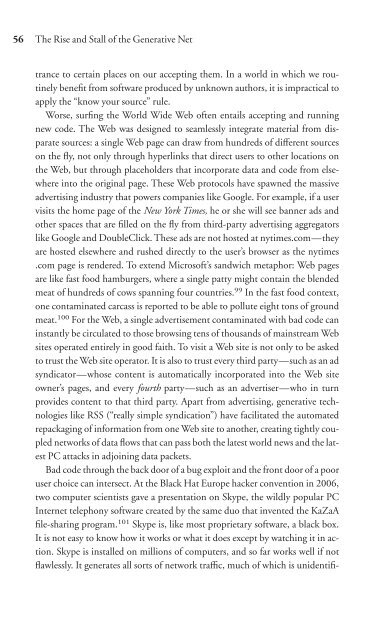Download - Future of the Internet â And how to stop it.
Download - Future of the Internet â And how to stop it.
Download - Future of the Internet â And how to stop it.
You also want an ePaper? Increase the reach of your titles
YUMPU automatically turns print PDFs into web optimized ePapers that Google loves.
56<br />
The Rise and Stall <strong>of</strong> <strong>the</strong> Generative Net<br />
trance <strong>to</strong> certain places on our accepting <strong>the</strong>m. In a world in which we routinely<br />
benef<strong>it</strong> from s<strong>of</strong>tware produced by unknown authors, <strong>it</strong> is impractical <strong>to</strong><br />
apply <strong>the</strong> “know your source” rule.<br />
Worse, surfing <strong>the</strong> World Wide Web <strong>of</strong>ten entails accepting and running<br />
new code. The Web was designed <strong>to</strong> seamlessly integrate material from disparate<br />
sources: a single Web page can draw from hundreds <strong>of</strong> different sources<br />
on <strong>the</strong> fly, not only through hyperlinks that direct users <strong>to</strong> o<strong>the</strong>r locations on<br />
<strong>the</strong> Web, but through placeholders that incorporate data and code from elsewhere<br />
in<strong>to</strong> <strong>the</strong> original page. These Web pro<strong>to</strong>cols have spawned <strong>the</strong> massive<br />
advertising industry that powers companies like Google. For example, if a user<br />
vis<strong>it</strong>s <strong>the</strong> home page <strong>of</strong> <strong>the</strong> New York Times, he or she will see banner ads and<br />
o<strong>the</strong>r spaces that are filled on <strong>the</strong> fly from third-party advertising aggrega<strong>to</strong>rs<br />
like Google and DoubleClick. These ads are not hosted at nytimes.com—<strong>the</strong>y<br />
are hosted elsewhere and rushed directly <strong>to</strong> <strong>the</strong> user’s browser as <strong>the</strong> nytimes<br />
.com page is rendered. To extend Micros<strong>of</strong>t’s sandwich metaphor: Web pages<br />
are like fast food hamburgers, where a single patty might contain <strong>the</strong> blended<br />
meat <strong>of</strong> hundreds <strong>of</strong> cows spanning four countries. 99 In <strong>the</strong> fast food context,<br />
one contaminated carcass is reported <strong>to</strong> be able <strong>to</strong> pollute eight <strong>to</strong>ns <strong>of</strong> ground<br />
meat. 100 For <strong>the</strong> Web, a single advertisement contaminated w<strong>it</strong>h bad code can<br />
instantly be circulated <strong>to</strong> those browsing tens <strong>of</strong> thousands <strong>of</strong> mainstream Web<br />
s<strong>it</strong>es operated entirely in good fa<strong>it</strong>h. To vis<strong>it</strong> a Web s<strong>it</strong>e is not only <strong>to</strong> be asked<br />
<strong>to</strong> trust <strong>the</strong> Web s<strong>it</strong>e opera<strong>to</strong>r. It is also <strong>to</strong> trust every third party—such as an ad<br />
syndica<strong>to</strong>r—whose content is au<strong>to</strong>matically incorporated in<strong>to</strong> <strong>the</strong> Web s<strong>it</strong>e<br />
owner’s pages, and every fourth party—such as an advertiser—who in turn<br />
provides content <strong>to</strong> that third party. Apart from advertising, generative technologies<br />
like RSS (“really simple syndication”) have facil<strong>it</strong>ated <strong>the</strong> au<strong>to</strong>mated<br />
repackaging <strong>of</strong> information from one Web s<strong>it</strong>e <strong>to</strong> ano<strong>the</strong>r, creating tightly coupled<br />
networks <strong>of</strong> data flows that can pass both <strong>the</strong> latest world news and <strong>the</strong> latest<br />
PC attacks in adjoining data packets.<br />
Bad code through <strong>the</strong> back door <strong>of</strong> a bug explo<strong>it</strong> and <strong>the</strong> front door <strong>of</strong> a poor<br />
user choice can intersect. At <strong>the</strong> Black Hat Europe hacker convention in 2006,<br />
two computer scientists gave a presentation on Skype, <strong>the</strong> wildly popular PC<br />
<strong>Internet</strong> telephony s<strong>of</strong>tware created by <strong>the</strong> same duo that invented <strong>the</strong> KaZaA<br />
file-sharing program. 101 Skype is, like most proprietary s<strong>of</strong>tware, a black box.<br />
It is not easy <strong>to</strong> know <strong>how</strong> <strong>it</strong> works or what <strong>it</strong> does except by watching <strong>it</strong> in action.<br />
Skype is installed on millions <strong>of</strong> computers, and so far works well if not<br />
flawlessly. It generates all sorts <strong>of</strong> network traffic, much <strong>of</strong> which is unidentifi-


